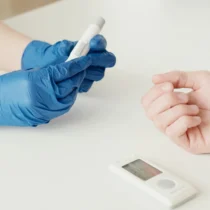Introduction
Diabetes is a chronic health condition that affects millions of people worldwide. It occurs when the body is unable to properly regulate blood sugar (glucose) levels, leading to a range of potential health complications. With proper management, individuals with diabetes can lead healthy,  fulfilling lives. This article explains the types of diabetes, its causes, symptoms, and effective strategies for managing the condition.
fulfilling lives. This article explains the types of diabetes, its causes, symptoms, and effective strategies for managing the condition.
In this article you will find information about the Diabetic topics below:
What is Diabetes?
Symptoms of Diabetes
Cause and risk factors
Complications of Diabetes
How to live with Diabetes
What is Diabetes?
Diabetes is a metabolic disorder characterized by high blood sugar levels over a longer period. This happens when the body doesn’t produce enough insulin (a hormone that manages blood sugar) or cannot effectively use the insulin it produces. There are three main types of diabetes:
- Type 1 Diabetes: An autoimmune condition where the body’s immune system attacks and destroys insulin-producing cells in the pancreas. People with Type 1 diabetes require lifelong insulin therapy. It often develops in childhood or adolescence but can occur at any age.
- Type 2 Diabetes: The most common form of diabetes, accounting for about 90% of cases. It occurs when the body becomes resistant to insulin or doesn’t produce enough insulin. Type 2 diabetes is often linked to lifestyle factors such as obesity, physical inactivity, and poor diet. It typically develops in adults but is increasingly seen in younger populations due to rising obesity rates.
- Gestational Diabetes: This type occurs during pregnancy and usually resolves after childbirth. However, it increases the risk of developing Type 2 diabetes later in life for both the mother and the child.
Symptoms of Diabetes
The symptoms of diabetes can vary but often include:
- Frequent urination
- Excessive thirst and hunger
- Unexplained weight loss

- Fatigue
- Blurred vision
- Slow-healing wounds
- Tingling or numbness in the hands or feet (a sign of nerve damage)
In Type 1 diabetes, symptoms can develop rapidly, while in Type 2 diabetes, they may appear gradually or go unnoticed for years.
Causes and Risk Factors
The causes of diabetes vary depending on the type:
- Type 1 Diabetes: The exact cause is unknown, but genetics and environmental factors (such as viral infections) are believed to play a role.
- Type 2 Diabetes: Risk factors include obesity, sedentary lifestyle, family history, age, and ethnicity (certain groups, such as African Americans, Hispanics, and Native Americans, are at higher risk).
- Gestational Diabetes: Hormonal changes during pregnancy can lead to insulin resistance, especially in women who are overweight or have a family history of diabetes.
Complications of Diabetes
If left unmanaged, diabetes can lead to serious health complications, including:
- Cardiovascular Disease: Increased risk of heart attack, stroke, and high blood pressure.
- Kidney Damage (Nephropathy): Diabetes is a leading cause of kidney failure.

- Nerve Damage (Neuropathy): Can cause pain, tingling, or loss of sensation, particularly in the extremities.
- Eye Damage (Retinopathy): Can lead to vision loss or blindness.
- Foot Problems: Poor circulation and nerve damage increase the risk of infections and amputations.
- Skin Conditions: Increased susceptibility to bacterial and fungal infections.
How to live with Diabetes
Living with diabetes requires ongoing attention and care, but it doesn’t have to limit one’s quality of life. Support from healthcare professionals, family, and diabetes support groups can make a significant difference. Advances in technology, such as continuous glucose monitors and insulin pumps, have also made diabetes management more convenient and effective.
Education is key—understanding the condition, its risks, and how to manage it empowers individuals to take control of their health. By adopting a proactive approach, people with diabetes can reduce their risk of complications and enjoy a full, active life.
While diabetes is a lifelong condition, it can be effectively managed through a combination of lifestyle changes, medication, and regular monitoring. Here are some key strategies:
- Healthy Eating: A balanced diet rich in whole grains, lean proteins, healthy fats, and vegetables can help regulate blood sugar levels. Limiting sugary and processed foods is essential.
- Regular Exercise: Physical activity helps improve insulin sensitivity and lowers blood sugar levels. Aim for at least 150 minutes of moderate exercise per week.
- Medication and Insulin Therapy: Depending on the type and severity of diabetes, medications or insulin injections may be necessary to manage blood sugar levels.
- Blood Sugar Monitoring: Regularly checking blood sugar levels helps individuals understand how their body responds to food, exercise, and medication.
- Weight Management: Maintaining a healthy weight is particularly important for individuals with Type 2 diabetes, as excess weight can worsen insulin resistance.
- Regular Check-ups: Regular visit to doctor or healthcare providers for blood tests, eye exams, and foot care can help detect and prevent furthercomplications.



